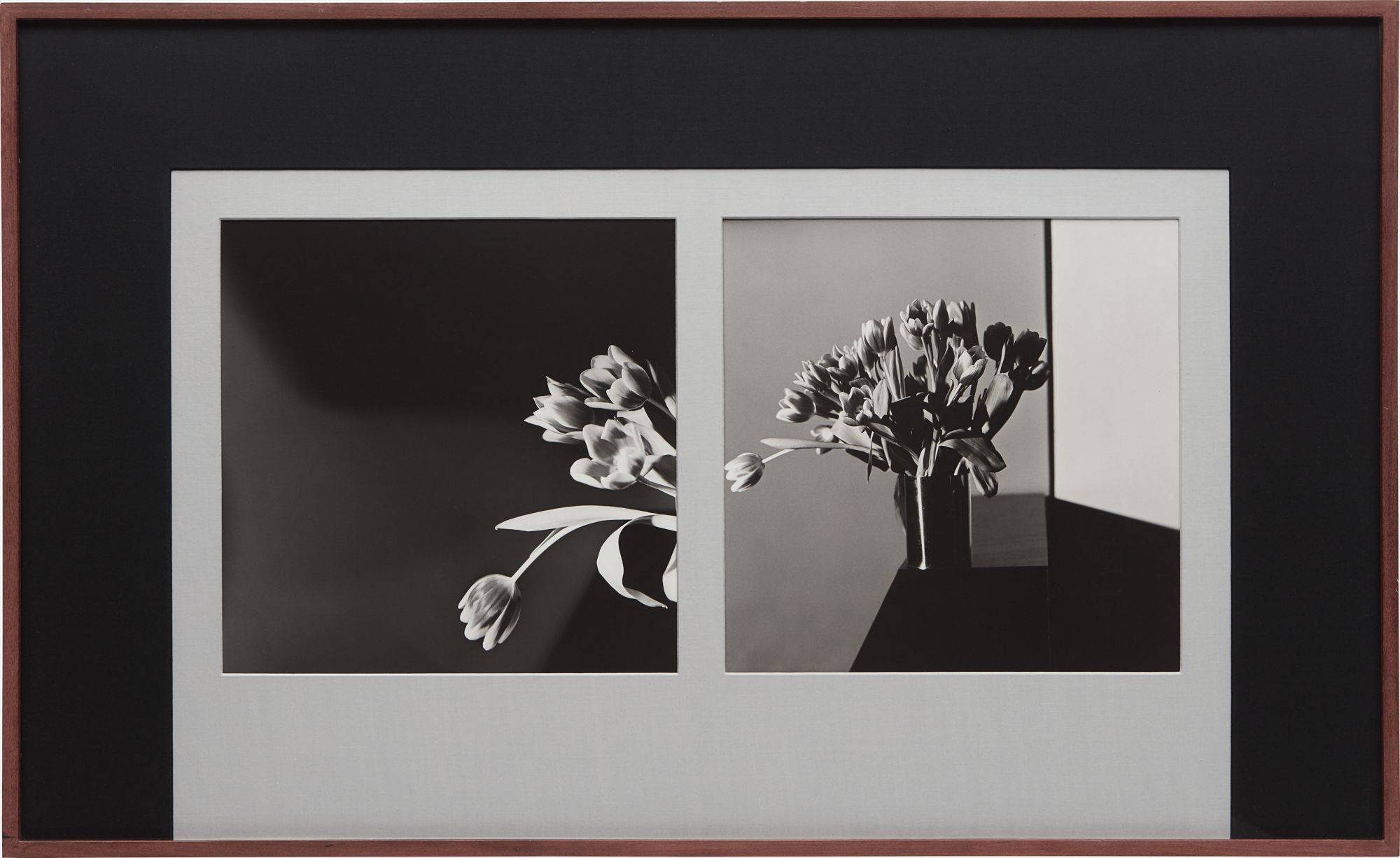

282
Robert Mapplethorpe
Tulips
Overall 25 x 41 in. (63.5 x 104.1 cm)
Full-Cataloguing
-John Ashbery, Robert Mapplethorpe: Pistils, Introduction
“In a sense, Sam Wagstaff created Robert Mapplethorpe,” wrote Dominick Dunne for Vanity Fair, continuing, “but anyone who knows Robert Mapplethorpe will tell you that he was ready and waiting to be created.” The 1970s would prove to be a pivotal decade with influential introductions for the young and talented Mapplethorpe. In 1971 he meets John McKendry, a curator at The Metropolitan Museum of Art, who gifts Mapplethorpe a Polaroid camera, and in 1972 Mapplethorpe is introduced to curator, collector, and consummate taste-maker Sam Wagstaff, who gifted Mapplethorpe a Hasselblad and went on to connect the emerging photographer to the influential collector Paul F. Walter in 1975. It was the last introduction to Walter that led to the creation of the unique diptych on offer, among Mapplethorpe’s first pictures of flowers.
Walter, like Wagstaff, was an ardent supporter and collector of photography in what was at the time, a still nascent market. While visiting Mapplethorpe’s Bond Street loft at Wagstaff’s invitation, Walter viewed portraits of acquaintances and fellow art-world luminaries including Helen Marden, minimalist artist Brice Marden’s wife, and Henry Geldzahler, a curator and passionate proponent of contemporary art. Created in diptych or triptych formats, these early portraits were surrounded by silk or velvet mats with custom framing—unique constructions that drew upon Mapplethorpe's studies at Pratt in sculpture as well as his experiments with mixed media. Seduced by this distinctive format, in December of 1975, Walter commissioned a portrait of his own from Mapplethorpe, presumably the first work by the artist to enter Walter’s growing photography collection.
Mapplethorpe’s reputation continued to develop, and in February 1977, just two years following the portrait of Walter, Mapplethorpe secured two concurrent solo exhibitions in which he simultaneously showed portraits at Holly Solomon Gallery, and sex images at The Kitchen. Following the exhibition openings and a celebratory dinner hosted by Wagstaff that Walter attended, Walter sent the bouquet of tulips that is now recognized as the subject of "one of Mapplethorpe’s most unforgettable images.” After seeing Mapplethorpe’s stunning photographs of his congratulatory gift, Walter commissioned Mapplethorpe to create the diptych on offer, Tulips, 1977, to be in the same style as the portrait from a few years before.
Reinforcing Tulips’ importance in Mapplethorpe’s oeuvre, just one year later, in 1978, the right panel of the diptych was chosen as the front cover for Mapplethorpe’s Y Portfolio, and in the same year Wagstaff selected both the right and left panels as the front and back cover of A Book of Photographs from the Collection of Sam Wagstaff, published with Gray Press. Later, in 1988, the present lot was exhibited in Mapplethorpe’s first museum retrospective in the United States at the Whitney Museum of American Art in New York.
As a unique and early masterwork by Mapplethorpe, and representative of this highly inventive time in the 1970s New York art scene, Tulips, 1977 is undeniably significant. It is further a testament to Wagstaff and Walter’s keen taste and commitment to photography that both men supported and recognized the young Mapplethorpe’s brilliance, as their collections have since become the foundations of major museum collections. The collection of Sam Wagstaff was acquired in 1984 by the J. Paul Getty Museum, Los Angeles, and Paul F. Walter was a generous donor to The Museum of Modern Art, New York where his photography collection was first displayed in a 1985 exhibition A Personal View: Photography in the Collection of Paul F. Walter.
This unique diptych has been held in just two private collections. The first of which is the collection of Paul F. Walter who commissioned the work in 1977. The work remained in Walter’s collection until 2005 when it was sold at auction to the present, private collector.
Robert Mapplethorpe
American | B. 1946 D. 1989After studying drawing, painting and sculpture at the Pratt Institute in the 1960s, Robert Mapplethorpe began experimenting with photography while living in the notorious Chelsea Hotel with Patti Smith. Beginning with Polaroids, he soon moved on to a Hasselblad medium-format camera, which he used to explore aspects of life often only seen behind closed doors.
By the 1980s Mapplethorpe's focus was predominantly in the studio, shooting portraits, flowers and nudes. His depiction of the human form in formal compositions reflects his love of classical sculpture and his groundbreaking marriage of those aesthetics with often challenging subject matter. Mapplethorpe's style is present regardless of subject matter — from erotic nudes to self-portraits and flowers — as he ceaselessly strove for what he called "perfection of form."